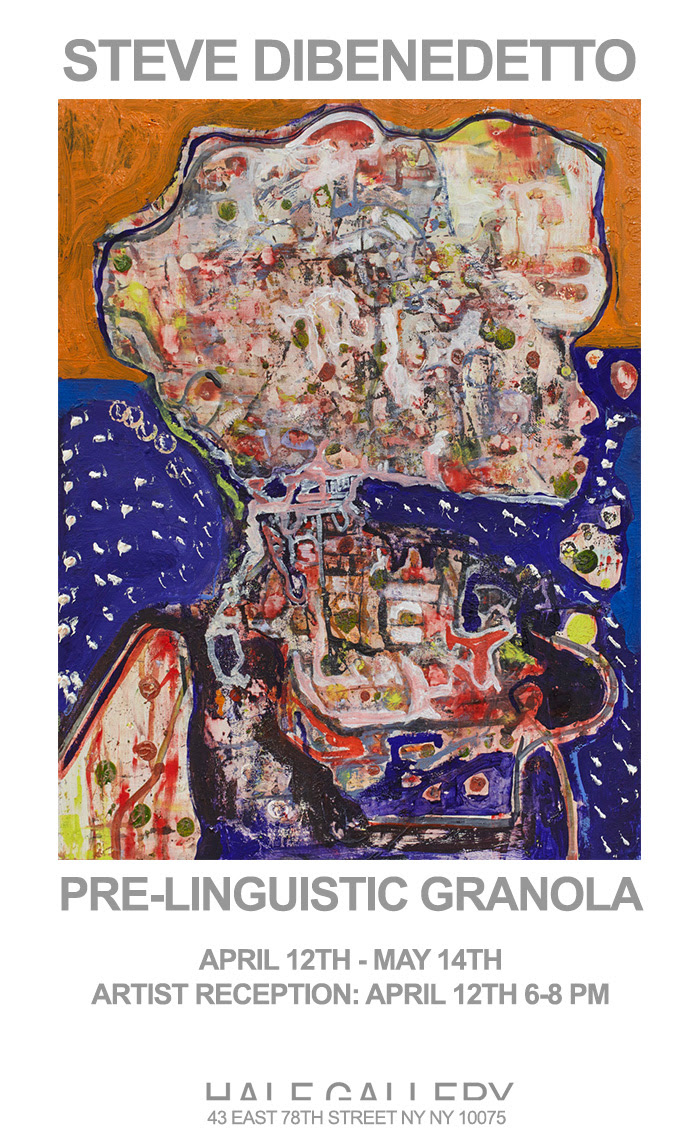
The artist is a kind of scientist and his project is to investigate the buzzing depths of our mind's neural background radiation. He describes his marks as "clumpages of data" and "procedural evidence," and the finished work as "the results of whatever excursion the painting has been on." It's a dispassionate way of discussing what looks like a colorful assortment of flamboyant and exuberant canvases; pictures that emote from every pore, warp at their edges, tremble with energy. These canvases are seemingly drenched in the sweat of effort, and yet, as he talks, the refined speech of the artist belies the primitive feelings his work evokes.
Like David Cronenberg or J.G Ballard, the artist is forever negotiating the seemingly infinite nature of intellect - he calls it "the micro shifting of endless judgements - with the meat of the corporeal body." He thinks about physical transgression and considers art-making a form of "adolescent misbehavior." He talks about "subjecting the painting to too much information" and "undermining its stability" and "abusing the work" as if the painting were an ersatz body, enduring his touch, accumulating a lifetime of scars, bruises, lesions and blemishes until it bears the complexion of a hard-lived life. Despite this, the work isn't overwhelmed with suffering, perhaps because that particular compulsion has been fully exorcised. What remains is unhinged ecstasy, freewheeling bliss.
The artist thinks about rock 'n' roll as a model for corrupting the canon of fine art. He plays the drums, an instrument that requires the sort of whacking and kicking and dragging and scraping needed to produce his gnarled abstractions. The stretched skins of the canvas and the drum are both primed to take a beating, but the artist denies a connection between his music and art. Here, he seems to pit himself against himself, encouraging the fugue of inner division.
Psychedelic is an operant descriptor for this work, but more for its ability to capture the unsettling feeling of seeing unreality than for its Summer of Love aesthetic. The layered abstraction in these paintings simultaneously disrupts and massages vision, never allowing the eyes the reassurance of either a subject or a non-subject. The images simultaneously suggest city maps and phantasmagoric topographies, electronic schematics and aboriginal sand paintings, patterns and chaos, implosion and explosion, Paul Cezanne and Led Zeppelin. The artist likes the conflict of these binaries. He thrives in liminal places. Its where he finds the richest confusion. It's where he does the best damage.
-Ross Simonini
UPTOWN!!
Silk Stocking district
and they have electrolytes.
RS for the NYT
Well, I hope he's learned a lesson.
proof how annoying a good (rs) review can be.
Unclench your you-know-what, Smith tells artists.
|
- steve 4-06-2016 4:51 am
The artist is a kind of scientist and his project is to investigate the buzzing depths of our mind's neural background radiation. He describes his marks as "clumpages of data" and "procedural evidence," and the finished work as "the results of whatever excursion the painting has been on." It's a dispassionate way of discussing what looks like a colorful assortment of flamboyant and exuberant canvases; pictures that emote from every pore, warp at their edges, tremble with energy. These canvases are seemingly drenched in the sweat of effort, and yet, as he talks, the refined speech of the artist belies the primitive feelings his work evokes.
Like David Cronenberg or J.G Ballard, the artist is forever negotiating the seemingly infinite nature of intellect - he calls it "the micro shifting of endless judgements - with the meat of the corporeal body." He thinks about physical transgression and considers art-making a form of "adolescent misbehavior." He talks about "subjecting the painting to too much information" and "undermining its stability" and "abusing the work" as if the painting were an ersatz body, enduring his touch, accumulating a lifetime of scars, bruises, lesions and blemishes until it bears the complexion of a hard-lived life. Despite this, the work isn't overwhelmed with suffering, perhaps because that particular compulsion has been fully exorcised. What remains is unhinged ecstasy, freewheeling bliss.
The artist thinks about rock 'n' roll as a model for corrupting the canon of fine art. He plays the drums, an instrument that requires the sort of whacking and kicking and dragging and scraping needed to produce his gnarled abstractions. The stretched skins of the canvas and the drum are both primed to take a beating, but the artist denies a connection between his music and art. Here, he seems to pit himself against himself, encouraging the fugue of inner division.
Psychedelic is an operant descriptor for this work, but more for its ability to capture the unsettling feeling of seeing unreality than for its Summer of Love aesthetic. The layered abstraction in these paintings simultaneously disrupts and massages vision, never allowing the eyes the reassurance of either a subject or a non-subject. The images simultaneously suggest city maps and phantasmagoric topographies, electronic schematics and aboriginal sand paintings, patterns and chaos, implosion and explosion, Paul Cezanne and Led Zeppelin. The artist likes the conflict of these binaries. He thrives in liminal places. Its where he finds the richest confusion. It's where he does the best damage.
-Ross Simonini
- steve 4-06-2016 4:52 am [add a comment]
UPTOWN!!
- Skinny 4-06-2016 12:36 pm [add a comment]
Silk Stocking district
- steve 4-06-2016 1:00 pm [add a comment]
and they have electrolytes.
- bill 4-25-2016 9:05 am [add a comment]
RS for the NYT
- bill 5-06-2016 2:20 am [add a comment]
Well, I hope he's learned a lesson.
- steve 5-06-2016 6:43 am [add a comment]
proof how annoying a good (rs) review can be.
- bill 5-06-2016 9:53 am [add a comment]
Unclench your you-know-what, Smith tells artists.
- tom moody 5-06-2016 1:19 pm [add a comment]